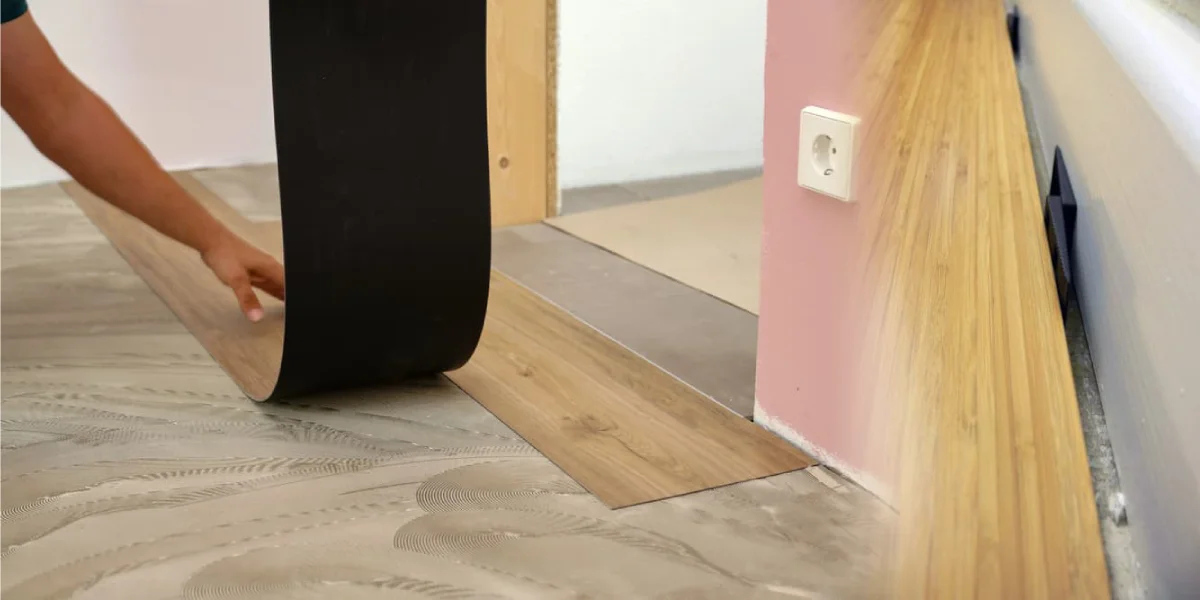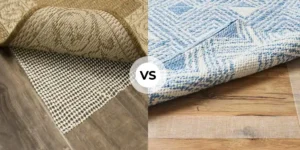If you’re thinking about opting for glue-down vinyl flooring in your space.
It’s important to understand how it behaves over time. Equally important is does glue-down vinyl flooring expands. And whether the expansion is something to be concerned about.
Most vinyl flooring, including the glued-down variety, expands and contracts as it ages. Because of changing temperature and humidity.
To accommodate this natural expansion and contraction. It’s crucial to leave a gap around the room’s perimeter. And at any points where the flooring changes direction or encounters elevation differences.
Doing so gives the material room to expand and contract without causing issues. Like buckling or lifting away from the subfloor.
The durability, cost-effectiveness, ease of installation, and visually appealing factors. Answers why glue-down vinyl flooring is becoming so popular with homeowners.
In this article, we will delve into the reasons behind this phenomenon. And will provide you with valuable insights and answers.
Does Glue Down Vinyl Flooring Expand?
Yes, glue-down vinyl flooring can expand. Like many materials, vinyl can be influenced by changes in temperature and humidity. When exposed to heat or moisture, the vinyl may expand slightly.
Rest assured, this is a natural process that occurs and shouldn’t cause major concerns.
To accommodate for this potential expansion. It’s crucial to leave proper expansion gaps during installation.
This gap should be a minimum of 3-5 mm, for glue-down vinyl flooring. It allows the flooring to move freely as the temperature and humidity change. It also helps reduce the risk of warping or buckling the planks.
These gaps give the flooring space to expand without causing issues like buckling or warping.
Additionally, fill this expansion gap with a flexible sealant to prevent dirt and moisture buildup.
Factors Influencing Flooring Expansion
Several factors can influence the expansion of floors, including:
- Temperature: Temperature changes can cause vinyl flooring to expand or contract. These fluctuations can lead to gaps and cracks in the flooring if not accounted for properly.
- Humidity: The moisture levels in the environment also play a role in floor expansion. High humidity can cause hardwood to expand due to moisture absorption. Conversely, low humidity levels can result in contraction as the materials lose moisture.
- Installation Process: Proper installation techniques are crucial to minimizing floor expansion. Leaving an expansion gap around the floor’s perimeter is important to prevent direct contact with walls. A 5/15″ gap is recommended between the floor’s edge and any obstructions like walls or support columns.
- Using the Right Adhesive: Using the adhesive recommended by the flooring manufacturer is essential. Too much adhesive can cause the floor to buckle, while insufficient adhesive may result in inadequate adherence. Follow the instructions provided by the manufacturer when applying and spreading adhesive.
- Subfloor Conditions: A stable foundation is essential for the floor’s performance. Properly preparing and evaluating the subfloor is crucial. As an uneven or unstable subfloor can transfer stress to the floor, leading to uneven expansion or contraction.
What Types of Vinyl Floors Have the Most Expansion Issues?
Sheet Vinyl
Sheet vinyl is some of the most affordable flooring you can buy. These flexible materials are 6 to 12 feet wide and can be cut to any length.
For busy households, sheet vinyl is a great option because it is low maintenance and easy to clean. It is also water-resistant and can be used in moisture-prone rooms. Sheet vinyl is available in various colors and patterns to suit any style.
There can be expansion problems with sheet vinyl flooring. Especially when installed over large areas without large expansion joints.
Without enough expansion room, sheet vinyl can buckle or warp. When exposed to changes in temperature or humidity. Even though the glue makes it difficult to move and lift, the material can still spread.
When working with traditional sheet vinyl, it is recommended that you leave an expansion gap around the perimeter.
Loose Lay Vinyl
Loose vinyl planks are primarily known for their ease of installation. But, this flooring has a major drawback: it isn’t available in tile format, making it difficult to install.
Loose vinyl flooring is also susceptible to expansion problems. Since it relies on friction rather than adhesive to stay in place. When the floor expands due to changes in temperature or humidity. It can undermine its stability.
It can lead to buckling and warping of the flooring. Which can cause a tripping hazard and is difficult to repair.
Floating Vinyl Floor
Floating floors consist of separate pieces that connect with a click-and-lock mechanism. You won’t need adhesive when you measure and install them correctly.
Temperatures and humidity don’t seem to affect it much. It’s also relatively easy to replace individual tiles or planks if damaged. Floating floors are also a good choice for people who want a flooring solution that can be installed quickly.
Still, you should leave space on vertical surfaces like walls and pipes. Especially in large rooms, expansion seams are necessary.
Low-Quality Vinyl
Low-quality or improperly manufactured vinyl flooring can have more expansion problems.
The material may be too thin or contain too many plasticizers. Which can cause it to expand and contract more than higher-quality vinyl flooring. It can lead to premature wear, buckling, or cracking.
Depending on the composition, these floors may not be able to withstand the required stability. Or may have structural defects. Choose vinyl flooring from reputable manufacturers to cut the risk of expansion-related problems.
Also See: 12 Things You Need to Know Before Buying Vinyl Flooring
How to Prevent the Expansion and Contraction of Vinyl Floors?
- Acclimate the Vinyl: Before installing, let the vinyl planks or tiles sit in the room for a couple of days. This helps them adjust to the temperature and humidity of the space.
- Use Proper Underlayment: Choose a suitable underlayment that provides insulation and helps regulate temperature. This helps minimize the impact of temperature changes on your vinyl flooring.
- Leave Expansion Gaps: When installing, leave small gaps around the edges of the room. These gaps give the vinyl room to expand and contract without causing issues like buckling or warping.
- Control Indoor Climate: Maintain a stable indoor climate. Keep the room temperature and humidity levels within the recommended range for your vinyl flooring. This prevents extreme fluctuations that can affect the material.
- Avoid Direct Sunlight: Limit direct sunlight exposure on your vinyl floors, especially if they are near windows. Prolonged exposure to sunlight can lead to temperature variations, causing the flooring to expand or contract.
- Proper Installation: Follow the manufacturer’s installation guidelines carefully. Ensure that the subfloor is clean, dry, and level. A well-prepared subfloor contributes to the stability of your vinyl flooring.
- Regular Maintenance: Keep your vinyl floors clean and well-maintained. Sweeping or vacuuming prevents debris or grit from causing unnecessary stress on the flooring.
How Underlayment Controls Expansion?
- Temperature Buffer: Underlayment acts as a buffer against temperature changes. It helps your floors stay cozy in the winter and cool in the summer, preventing them from expanding or contracting too much.
- Moisture Protection: It adds a layer of defense against moisture. By keeping excess moisture at bay, underlayment helps prevent your flooring from warping or swelling.
- Even Surface: Underlayment creates a smooth and even surface for your flooring. This helps distribute weight more uniformly, reducing the chances of your floors reacting to changes in the room’s conditions.
- Noise Reduction: Besides controlling expansion, underlayment also dampens sound. It minimizes the noise created by footsteps or moving furniture, creating a quieter and more comfortable space.
- Comfort Underfoot: Underlayment adds a bit of cushioning, making your floors more comfortable to walk on. This extra padding contributes to the overall stability of your flooring.
List of underlayments suitable for glue-down vinyl flooring:
- Cork underlayment
- Rubber underlayment
- Felt underlayment
- Plywood underlayment
You Might Also Like to Read
- Cork vs. Rubber Underlayment: Which One Should I Choose?
- Cork vs. Foam Underlayment: Which is Right for Me?
Why Are Expansion Gaps So Important?
Most vinyl floors require expansion gaps to accommodate natural expansion and contraction. Floors can buckle, warp, or develop invisible cracks without these gaps.
As a result of expansion gaps, floors can expand, reducing the risk of damage and maintaining structural integrity.
Expansion gaps should be placed around the room’s perimeter and in areas wider than 15 feet. Gaps should be filled with a flexible sealant to allow for movement. Expansion gaps should also be checked periodically to ensure they are in good condition.
There is nothing wrong with expansion gaps; don’t fear them. Regardless, you need to cover the edges of a floating vinyl floor with trim around it. If you do it right, you won’t see gaps again – and your floor won’t be unsafe.
See Also: Do I Need Expansion Gaps for Vinyl Flooring? (Explained)
FAQs: Does Glue Down Vinyl Flooring Expand?
How big an expansion gap does vinyl plank flooring need?
A minimum of 1/4 inch expansion gap should be left around the room’s perimeter. Make sure to check manufacturer instructions for specific expansion gap requirements.
How much expansion can be expected in different conditions?
Specific conditions determine how much expansion glue-down vinyl flooring will experience.
Generally, vinyl flooring expands a few millimeters when temperature and humidity change. Expansion is determined by factors such as flooring size, thickness, installation method, and environmental conditions.
It’s crucial to leave an appropriate expansion gap during installation according to the manufacturer’s recommendations. This way, the flooring will not be damaged or affected by expansion or contraction.
Can glue-down vinyl flooring be installed in all climates?
Yes, glue-down vinyl flooring can be installed in various climates. But, it’s important to consider the specific product’s suitability for extreme temperatures or high humidity.
Some vinyl flooring options may have temperature and humidity limitations. So following the manufacturer’s guidelines is crucial to ensure proper installation. And minimize potential issues related to climate conditions.
Read More on Vinyl Floors
- Do I Need Expansion Gaps for Vinyl Flooring? (Explained)
- How to Get Waves Out of Vinyl Flooring? (4 Best Ways)
- How to Fix Vinyl Flooring Seams? (A Step-By-Step Approach)
- 5 Reasons Why Your Vinyl Plank Floor Buckling (Guide To Fix It)
- How to Fix Gaps in Vinyl Plank Flooring? (5 Easy Steps)





